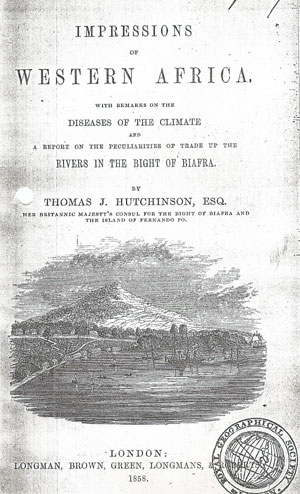|
Ireland, England and Africa
Thomas
Joseph Hutchinson (1802-1885) was born on 18 January 1802 in
Stonyford, Kilscoran parish of County Wexford.
(2) His father, Alfred Hutchinson,
was a petty landowner from an Anglo-Irish family with a
Protestant background. Although it was reported that Thomas
Hutchinson studied on the European continent and graduated as a
medical doctor from the University of Göttingen in 1833, there
are no surviving records in this institution that could confirm
this. He graduated on 2 January 1836 from the Apothecaries’
Hall, Dublin. By May 1843, Hutchinson was practicing as a
physician and surgeon at Saint Vincent's Hospital in Dublin, a
training ground for doctors and nurses. Six years later he
worked in the Poor Law Union of Wigan, Lancashire (England).
Between 1851
and 1855, Hutchinson was the senior surgeon on board the
Pleiad, for the expedition to the rivers Niger, Tshadda and
Binue, led by John Beecroft. On 29 September 1855, Thomas
Hutchinson was appointed British consul for the Bight of Biafra.
That year he married Mary, his lifelong wife, with whom he
arrived on 29 December 1855 in Port Clarence (later Santa Isabel
and present-day Malabo, capital of Equatorial Guinea), formerly
a Spanish dominion. Most of the business managed by Hutchinson
in Fernando Po was related to British affairs in the region,
which included chiefly the production and transport of palm oil
and occasionally other products. He also represented, albeit
unsuccessfully, a group of freed slaves and their families who
wished to be recognised as British citizens, and was a constant
arbiter between the ship masters and the local producers of raw
materials. (3)
A pioneer of
African cotton production, Hutchinson obtained in 1858 a tonne
of seeds from the Manchester Cotton Supply Associations to
undertake experiments on the continental coast of West Africa.
In his affairs, he was frequently partial to the interests of
certain Liverpool merchants, a practice for which he was
reprimanded by the Foreign Office. Hutchinson remained in Africa
until June 1860, when he and his wife returned to England for
health reasons, together with Fanny Hutchinson, an African girl
they had adopted. On 9 July 1861 he was replaced by Richard
Francis Burton (1821-1890), the celebrated explorer and
translator of The Book of One Thousand Nights and a Night.
(4)
Malaria
During the
journey of the Pleiad, Hutchinson conducted research on
the use of quinine as a preventative measure against the effects
of malaria. He insisted that, in small doses, quinine had a
favourable effect in preventing fever.
The benefits
of quinine were originally discovered by the indigenous peoples
of Peru, who extracted it from the bark of the cinchona tree (quina
quina in Quechua). An effective muscle relaxant, quinine was
used to halt shivering brought on by cold temperatures in the
Andes, and was brought to Europe by the Spanish in the early
seventeenth century. The bark was first dried, ground to a fine
powder and then mixed with wine. It was first used to treat
malaria in Rome in 1631. Large scale use of quinine as a
prophylaxis started around 1850, when it played a significant
role in the European colonisation of Africa. It was the prime
reason Africa ceased to be known as ‘the white man's grave’.
Hutchinson
explained that
My first experience there having been in a
Medical capacity, I made the subject of African malaria and
fever my continuous and attentive study. The truth of the old
maxim that “prevention is better than cure,” with which I
commenced my professional duties at Old Kalabar in the year
1850, which I followed up in the Niger Expedition of 1854, and
which I still practise as well as preach, has been abundantly
confirmed in my experience
(Hutchinson 1858: v).
|
Aboriginal wedding at
Fernando Po
(Hutchinson, Ten Years' Wanderings Among the
Ethiopians, 1861)
|
He ‘was
puzzled to understand how malaria could be generated. […]
Malaria and fever are cause and effect in Africa […] Endemic
fever attacks a large proportion of the crews of nearly every
ship sent out for the purpose of trading’ (Hutchinson 1855:
192). Therefore Hutchinson dedicated his efforts to
understanding how and when quinine should be administrated to
the crew members. ‘As soon as the expedition crosses the bar of
the river, [Niger] they should commence taking quinine, in the
proportion of six to eight grains per diem, one half in the
morning and one half in the evening’ (211).
In this
period, some believed that malaria was caused either by
submarine volcanic action or the action of vegetable matter upon
the sulphates. It was not until 1898 that Ronald Ross in India
proved that malaria was caused by mosquitoes carrying the
protozoan Plasmodium sp. Without knowing the cause of the
sickness, Hutchinson recommended prevention and a hygienic
environment.
Reflecting
Hutchinson’s entrepreneurial spirit, in the late 1850s Bailey &
Wills of Horsley Fields produced ‘Dr. Hutchinson's Quinine
Wine’, marketing it to ship owners and crews.
(5)
Argentina and Uruguay
With friends
and connections in the Foreign Office and various scientific and
business associations, among them George William Frederick, Earl
of Clarendon, and William Bingham Baring, Lord Ashburton, Thomas
Hutchinson managed to balance his consular work and medical
practice with exploration, travel writing and scientific
research. From 1858 to 1867 he was appointed Fellow of some
important institutions, including the Royal Geographical
Society, the Ethnological Society, the Royal Society of
Literature and the Anthropological Society. During his long
life, he was also elected honorary vice-president of the African
Institute of Paris, an honorary member of the Liverpool Literary
and Philosophical Society, foreign member of the Paleontological
Society of Buenos Aires, and founding member of the Society of
Fine Arts in Peru.
|
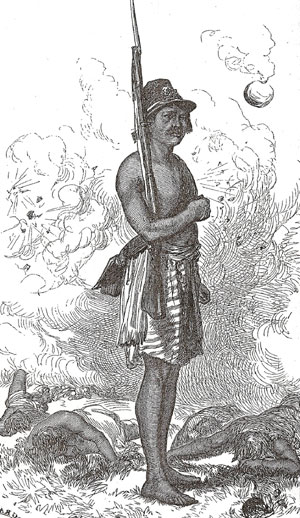
El Deber (the Paraguayan
Sentinel at his post)
(Hutchinson, The Paraná, with incidents
of the Paraguayan War, 1868)
|
Hutchinson's
next appointment was as consul in Rosario in the Argentine
province of Santa Fe. On 12 July 1861, he arrived with his
family to this city - at that time a small provincial town -
where he also acted as agent for Lloyds. According to Thomas
Murray there were rumours in Buenos Aires 'that Hutchinson got
his appointment and preference from the English Government for
betraying his friends. He was an Irishman and was, it is said,
one of O'Connell's secretaries' (Murray 1919: 310).
Hutchinson’s
ideological platform was quite distinct from Catholic
emancipation and Irish home rule. Therefore it is unlikely that
he had worked as O’Connell’s secretary. Hutchinson's connections
and friends, and his own record of service, were the principal
cause of his appointments in the consular service. This suggests
that the ‘rumours’ were probably the product of Murray’s marked
dislike of anything English.
Between 25
November 1862 and 10 March 1863, with the merchant Esteban Rams
and official support, Thomas Hutchinson organised an exploration
from Rosario to the River Salado in search of wild cotton. As a
result of this journey, he wrote Buenos Ayres and Argentine
Gleanings: with extracts from a diary of the
Salado
exploration in 1862 and 1863,
published in London in 1865.
In 1864 and
until 4 June 1865, Hutchinson was also Acting Consul for
Uruguay. In Montevideo, he owned the Farmacia Británica
at the corner of 25 de Mayo and Ituzaingo. On Hutchinson's
initiative, the governor of Santiago del Estero, Gaspar Taboada,
began testing to produce cotton in his province. In October of
1870 the family left Rosario for England.
Cholera and Native Diseases
Two cholera
epidemics broke out in Rosario in from March to May 1867 and
from December 1867 to February 1868. Cholera was a frequent
visitor during the summer heat and the rainy season. This time
the outbreak was out of control. In April 1867 alone there were
462 victims buried in the church cemetery. Hutchinson was
assisted by his wife and the Sisters of Mercy. They established
a sanatorium in their own house and rendered a great service to
the poor of the city by administering free medicines and
clothing. According to Richard Burton, Thomas and Mary
Hutchinson were scorned in the press by the local doctors. They
used bleeding as the basic treatment and sent dozens to the
grave, but Hutchinson cured his patients by administering
chloroform, chlorodyne, brandy, and turpentine (Burton 1870:
324).
Hutchinson
observed that ‘in some cases, the process just described
occurred in a period of five or six hours from the appearance of
the first signs of symptoms’ of the disease (Hutchinson 1867:
110). He added that the cause was unknown, as ‘it has been since
cholera broke out in 1665 in London or in 1807 in Jessore,
Hindustan, when it extended to Asia and took millions of lives’
(115). (6) He insisted on the use of
quinine as the only prophylactic medicine.
For his
great services during the epidemic, the governor of Santa Fe
province Nicasio Oroño gratefully mentioned Hutchinson in his
message to the provincial parliament. Furthermore, in July 1867
Hutchinson was presented with a gold medal by the Union Masonic
Lodge of Rosario.
During a
journey through the northern part of Argentina, Hutchinson also
studied an intermittent fever, locally known as ‘chuchu’.
(7) ‘Muleteers going from either of
the latter [La Rioja] to one of the former provinces
[Catamarca], and having already suffered from the mild species
of this disease are most predisposed to take it on coming within
its sphere of germination. In such cases it proves fatal to a
large per-centage’ (Hutchinson 1865: 182-183).
His
observations on the South American flora were significant and
completed his medical practice. Yerba mate (Ilex
paraguarensis), a highly-caffeinated tea regularly drunk in
Brazil, Paraguay, Argentina, Uruguay, and other countries, has
been the object of frequent commercial enterprises to export it
to Europe. Hutchinson wrote that
there are two qualities of this herb of the
Paraguaya, styled respectively the caa-guazu (large herb) and
caa-mi (small herb). […] When the leaves are fit to be pulled,
they are gathered, toasted, and pulverized. This is done under a
shed, made of posts and covered with the branches of trees. […]
The quantity of yerba exported from Paraguay in a year is
incalculable
(Hutchinson 1865: 142).
|
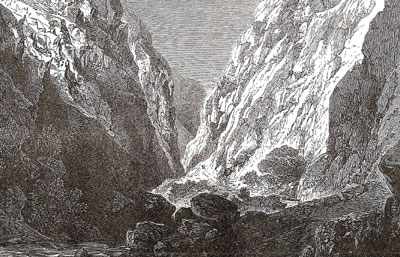
Ravine on Oroya Railroad
Track
(Hutchinson, Two Years in Peru, 1873)
|
Peru
In 1870
Thomas J. Hutchinson was appointed British consul at Callao, the
port of Lima, where he arrived with his family on the
Cordillera on 22 April 1871. Most of his work in Peru had to
do with shipping, in particular with the problems of crimping by
British and other ship captains. (8)
He also dedicated time to travel and to exploring vestiges and
the burial grounds of the indigenous peoples previous to the
Spanish conquest, an experience he recorded in the two volumes
of Two Years in
Peru, with
Exploration of its Antiquities
(1873).
In his book,
Hutchinson focused on the shipping trade and also on his new
archaeological interests. He regarded the Andean nation as ‘a
mine of archaeological lore, as inexhaustible as her treasures
of silver and gold’ (Hutchinson 1873, I: vii). A good portion of
the first volume includes extracts of his consular reports about
the trade in Callao, with details of agriculture and mining in
Peru. Most of the second volume is dedicated to the archaeology
of ancient cultures in the Andes.
Permeated by
the spirit of illustration and progress, and influenced by the
typical British perception of Latin America in that period,
Hutchinson presented an enthusiastic vision of Peru as a leading
country that
has entered a
new era. […] With these we have the daily-increasing commercial
spirit, chiefly called into life by the Pacific Steam Navigation
Company […]. Peru has a greater length of railways than any
other South American Republic, or even than Brazil. She has
reformed municipalities - made grants for bringing out
schoolmasters from Europe - is putting forth educational and
scientific schemes - proposes outlay for immigration purposes -
and through Congress, as well as the Executive, is presenting to
the world the tout-ensemble of a regenerating progress - needing
only the security of permanent tranquillity to make her hold a
primary position amongst the nations of the world
(I: xiv).
|
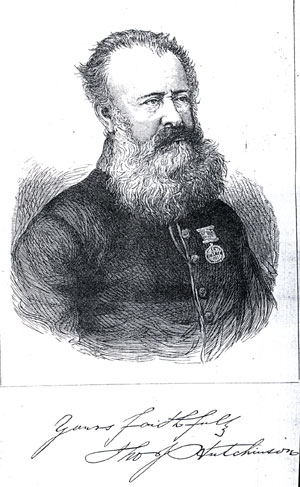
(Hutchinson, The
Paraná, 1868)
|
Barbarous Fashions and Civilised Houses
Scarce in medical descriptions,
Hutchinson’s
Two Years in Peru abounds with archaeological descriptions
and commercial reports, as well as in observations and remarks
about the people that are enriched by his medical experiences in
Africa and the Río de la Plata region. ‘The Conibos […] have the
barbarous fashion of flattening the heads of their children with
two small pieces of thin board - one of which is applied to the
forehead, and another behind - in such a manner that the front
of the head is pushed down, and the head enlarged posteriorly,
resembling the skulls that are sometimes turned out of the
burial-grounds (huacas) in the sierras’ (II: 83). Opposite to
this ‘barbarous fashion’ were the works of European residents,
like the
hospital of
Pacasmayo,
in the northern part of the country. Hutchinson visited Dr.
Heath’s ‘excellent institution, like all those built by Mr.
Meiggs, with capacity for accommodating forty to fifty patients’
(II: 167).
The description of houses reflects the same contrast between
the ‘houses at
San José
[…] are most miserable and uncomfortable of residences. […] Not
whitewash, and no arches, no comfortable promenade, excepting
what is built by the foreigners (II: 216).
Retirement and Travel Writing
Hutchinson
resigned from the Consular Service in 1874, though he had been
on leave and off-duty since November 1872. On 21 April 1874 he
was granted a life pension. The family went to live in
Ballinescar Lodge in Curracloe, St. Margaret's parish, County
Wexford, where Hutchinson dedicated himself to writing about his
travel experiences. He travelled through Germany and France, and
in 1876 he published Summer Holidays in Brittany. Then he
moved to Chimoo Cottage Mill Hill near Hendon in the English
county of Middlesex, and finally to northern Italy. Hutchinson
died on 23 March 1885 in his apartment at 2 Via Maragliano,
Florence. He was survived by his wife Mary Hutchinson and their
adopted daughter Fanny Hutchinson.
Edmundo Murray
Notes
1 I am thankful to SILAS Treasurer
Edward Walsh (London)
for his generous hospitality and expert guidance through the
intricacy and formalities of the city's various libraries and
archives. I am also grateful to Roberto Landaburu of Venado
Tuerto for sharing with me interesting information about
Hutchinson, and to genealogist Helen Kelly of Dublin for her
research on the Hutchinson family in Wexford archives.
2 Although
1820 is
mentioned in some sources as the year of birth.
3 The former slaves were liberated
by a British battleship and wished to become British citizens.
They bore English names and spoke pidgin, a mix of
African languages, English and Spanish. They were labelled
Fernandinos by the local population. Some of their names are
visible on the abandoned graves at the old cemetery of
Barrio Ela Nguema,
Malabo.
4 Later in 1865, Captain Burton
followed Hutchinson to South America as the British consul in
Santos,
Brazil. In 1868 he visited Hutchinson
in Rosario.
5 Some other quinine wine brands
were Waters’, Goodall's and Lyman’s. By the end of the
nineteenth century the quinine wines started to be marketed as
tonic waters (eg. Canada Dry, Schweppes). The bitter taste of
anti-malarial quinine tonic led officers and employees of the
British East India Company to mix it with gin, thus creating the
gin and tonic cocktail.
6 In 1866, the British
epidemiologist William Farr identified contaminated drinking
water as the likely source of the disease. However, only in 1883
Robert Koch identified Vibrio cholerae as the bacillus
responsible for the disease.
7 Chucho. Hutchinson’s
writing includes frequent and startling misspellings of common
nouns, toponyms and other proper names in Spanish and French
languages.
8 ‘Crimping’ (‘Shanghaiing’ in
American English), was the practise of conscripting men as
sailors by coercive techniques such as trickery, intimidation,
or violence.
References
- Burton,
Richard F. Letters from the battlefields of
Paraguay
(London: Tinsley, 1870).
- Hutchinson
T. J. ‘El cólera en el Rosario. Informe sobre la epidemia en el
Rosario, durante el mes de abril de 1867’ in Revista
Médico-Quirúrgica (Buenos Aires), 4:7 (8 July 1867), pp.
106-12.
- Hutchinson
T. J. Buenos Ayres and Argentine Gleanings: with extracts
from a diary of the
Salado
exploration in 1862 and 1863
(London: Edward Stanford, 1865).
-
Hutchinson T. J. Impressions of Western Africa, with remarks
on the Diseases of the Climate and a Report on the Peculiarities
of Trade Up the Rivers in the Bight of Biafra (London:
Longman, Brown, Green, Longmans and Roberts, 1858).
-
Hutchinson T. J. Narrative of the Niger, Tshadda, & Binuë
Exploration, including a Report on the Position and Prospects of
Trade up those Rivers, with Remarks on the Malaria and Rivers of
West Africa (London: Longman, Brown, Green and Longmans,
1855).
- Hutchinson
T. J. Our Meat Supply from Abroad: A paper read before the
Liverpool
Literary and Philosophical Society, January 9th 1871
(Liverpool: David Marples, 1871).
- Hutchinson
T. J. Summer Holidays in
Brittany
(London: Sampson Low, Marston, Searle, & Riwigton, 1876).
- Hutchinson
T. J. Ten Years' Wanderings among the Ethiopians; with
sketches of the Manners and Customs of the Civilized and
Uncivilized Tribes, from
Senegal to
Gabon
(London: Hurst and Blackett, 1861).
- Hutchinson
T. J. The Paraná; With Incidents of the Paraguayan War, and
South American Recollections from 1861 to 1868 (London:
Edward Standford, 1868).
- Hutchinson
T. J. Two Years in
Peru, with
Exploration of its Antiquities
(London: Sampson Low, Marston, Low & Searle, 1873). Two volumes.
- Hutchinson
T. J. Up the Rivers and Through Some Territories of the Rio
de la Plata Districts in South America [Read at the 38th
Meeting, 1868, of the British Association for the Advancement of
Science, in Norwich, on the 21st of August, Section
E, Geography and Ethnology] (London: Bates Hendy & Co.,
1868).
|

